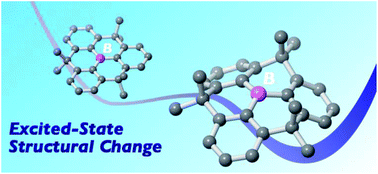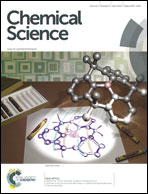Constraint-induced structural deformation of planarized triphenylboranes in the excited state†
Abstract
Triphenylboranes planarized with three methylene bridges exhibited dual fluorescence bands around 340 and 400 nm despite their structural constraint. To elucidate the origin, their excited state dynamics were experimentally and theoretically studied. The measurements of fluorescence lifetimes and transient absorption spectra indicated that the planarized triphenylboranes adopt two local minimum structures in the lowest-energy excited singlet (S1) state. The TD-DFT potential energy surface of the S1 state possesses at least two minimum energy structures associated with a planar and a bowl-shaped molecular structure. The theoretical S1–S0 transition energies at these geometries were in good agreement with the experimentally observed values. These results indicated that the plane-to-bowl structural relaxation in the S1 state is the origin of the dual fluorescence. Based on the calculated partial atomic charge on the boron atom, the structural deformation to the bowl-shaped structure results in an increase in the electron density on the boron center. Thus, the enhanced intramolecular charge-transfer character plays a role in this structural deformation. Similar behavior was also observed for trigonally π-expanded planarized borane derivatives. These results provide an important implication that structural constraint in a planar fashion is not only a strategy to construct a rigid skeleton, but also a viable mechanism to impart flexibility to the skeleton.


 Please wait while we load your content...
Please wait while we load your content...